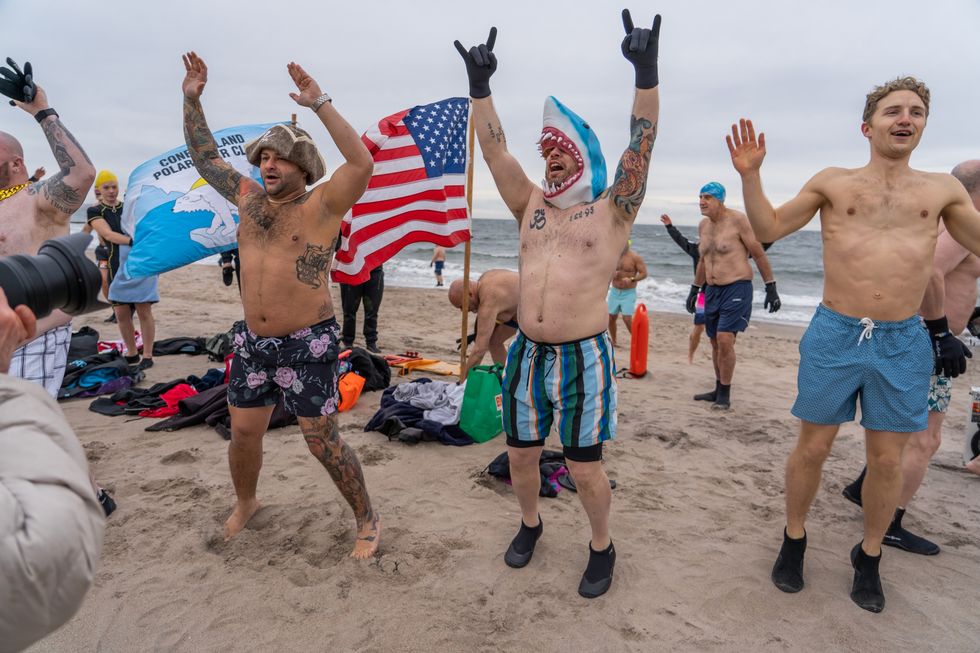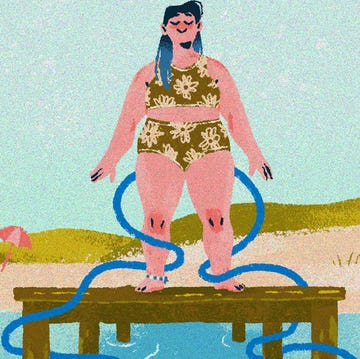I am standing on the Coney Island boardwalk violently shivering. It’s January. Despite the obvious winter weather, I’m wearing only a bathing suit and towel — a choice I’m starting to question when the Coney Island Polar Bear Club parades by blasting “Eye of the Tiger” on an oversize boom box. Despite my initial misgivings, I’m here to join 85 euphoric club members throwing a dance party on their way to the beach. After participating in the pre-swim ritual of a few sandy jumping jacks, I grab hands with the people closest to me and plunge into the Atlantic Ocean.
It may seem unusual to joyfully embrace the cold, something that the Coney Island Polar Bear Club has been doing every Sunday from November to April since 1903. While they’re the oldest polar plunge club in the United States, the practice of voluntarily submerging in icy water stretches back much further. In Eastern Europe, records of winter swimming holes cut directly in the ice, some in the shape of the cross in honor of the Orthodox Christian Epiphany, date back to 1525.
Sure, it’s possible to visit Antarctica, where for the ultimate bragging rights, you can take a polar plunge in water that hovers around 35 to 45 degrees Fahrenheit, just above the freezing point. However, a local body of cold water offers the same semi-painful physical shock value, according to Coney Island Polar Plunge Club president Dennis Thomas, whose 35-year-long tenure with the group started on a whim.
“I used to come on bleak days because it had so much atmosphere,” Thomas says, gesturing to the nearby amusement park attractions. “I was on the boardwalk, and I saw these old guys standing in bathing suits, running down and going in the water. I just thought, ‘That’s really crazy! I want to do that!’ I tried it once, expecting to only do it one time. I thought, ‘That’s not so bad. I could do it again.’ And I just kept coming back.”
When I ask for pre-swim advice, Thomas warns me that it will feel like “every cell of your body is fighting against the idea of going in,” and if you can stay in the water for at least three minutes, the experience becomes slightly less overwhelming. (“I wouldn’t say you ever get used to it, but you do adjust,” he says with a laugh.) Thomas also points out that while experienced club members generally swim for about 10 minutes, it’s ultimately a go-at-your-own-pace scenario. “We don’t ask anyone to suffer,” he says. “It’s not why we’re here.”
The experience of hurling my body into the water felt all-consuming but not torturous — even if my shrieks and gasps might have suggested otherwise. (I took the advice of another club member to vocalize what I was feeling.) Jumping into cold water provides a natural high. There are also well-documented medical benefits that include a boost to the immune system, improved circulation, and overall improved cardiovascular health. It can also reduce stress, mainly because it’s incredibly difficult to focus on your worries when you’re too busy adapting to the extreme sensation of cold water.
“It leaves you with a sense of being able to accomplish whatever life throws your way,” Henriette Sophia Danielsen, a communication adviser and ice swimming enthusiast from Stockholm, Sweden, tells me. “The benefits are endless, and you can feel them instantly. The rush of endorphins, that feeling of awakening the whole nervous system, and the warm sensation in your whole body afterwards. You just need to overcome your fear and embrace the uncomfortable.”
Ice swimming. Cold showers. Ice baths. Polar plunging. Cold water therapy. Whatever you call it, the act of dipping into colder-than-cold water has reached a new level of popularity in recent years. Cold water swimming officially became an organized sport in 2009 with the creation of the International Ice Swimming Association, which holds events in bodies of water 41 degrees Fahrenheit or less. Every March, Chicago holds one of the biggest national polar plunge events, which has attracted the likes of Conan O’Brien, Lady Gaga, and Vince Vaughn to grin and bear it to raise money for the local chapter of the Special Olympics.
For frequent swimmers, plunges can also serve as an important source of community, something that became startlingly obvious with the members of the Coney Island club, many of whom wore masks and costumes for their dips simply to inspire laughs. More than 130 swimmers call Coney Island their home club. They represent different ages, races, genders, political affiliations, and occupations, serving as a reflection of the diverse population of New York City.
Standing on the beach after my brief swim, once again wrapped in a towel, I felt surprisingly warm. It wasn’t just the promised improved circulation surging through my body. I had expected this to be a one-and-done experience. Instead, I unlocked a healthy new communal activity that was so tantalizing, I actually caught myself considering what protective hand and foot gear I might need for my next plunge.
Laura Studarus is a Los Angeles-based travel writer who has contributed to Fast Company, BBC Travel, and Thrillist.
Get Shondaland directly in your inbox: SUBSCRIBE TODAY















